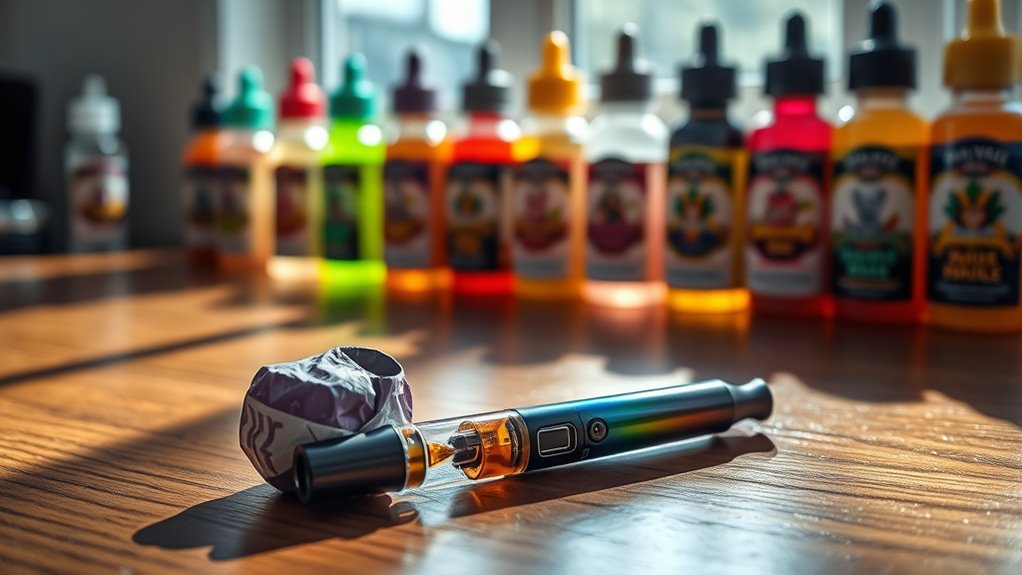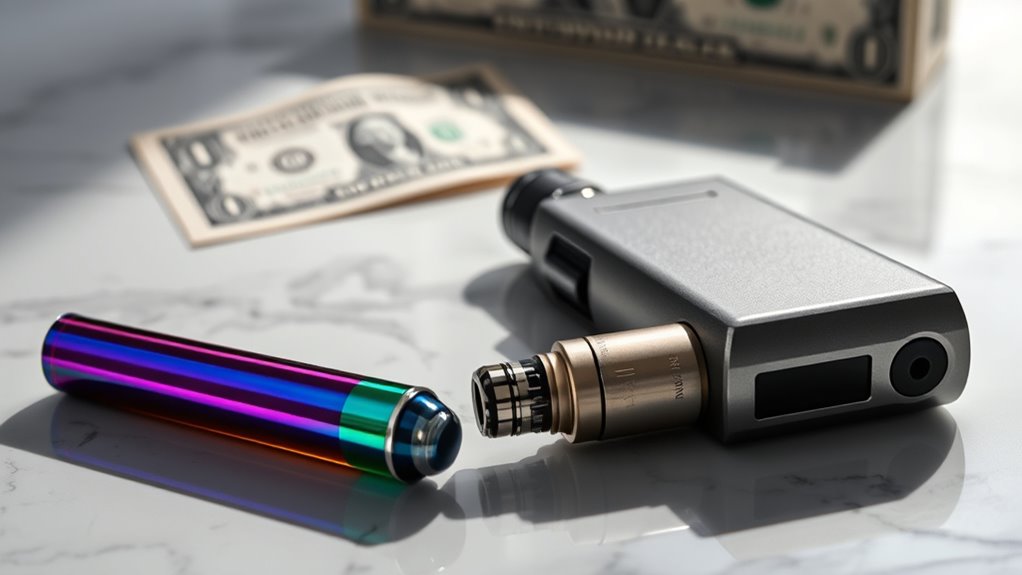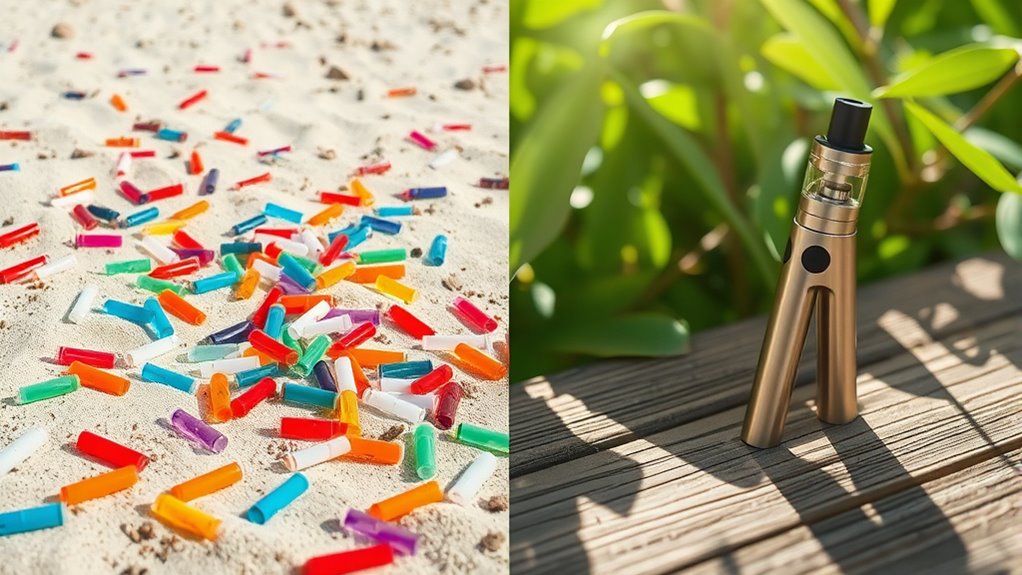When choosing between disposable and rechargeable vape pens, consider your vaping habits. Disposable pens offer convenience and low upfront costs, perfect for occasional users, but they can become pricey and contribute to waste over time. Rechargeable pens have higher initial costs, but they provide customizable settings and lower long-term expenses, making them ideal for frequent vapers. Each option has its pros and cons, and learning more about both can help you make the best decision for your lifestyle.
Key Takeaways
- Disposable vape pens offer convenience with no setup or maintenance, ideal for novice and occasional users.
- Rechargeable vape pens provide customizable settings, appealing to frequent users seeking a tailored vaping experience.
- While disposables have a low initial cost, their frequent repurchases lead to higher long-term expenses.
- Rechargeables have a higher upfront cost but result in lower ongoing expenses and less electronic waste over time.
- Environmental impact favors rechargeable pens, reducing landfill waste by up to 80% compared to disposables.
Overview of Disposable Vape Pens

When you're looking for a hassle-free vaping experience, disposable vape pens are a convenient choice.
These single-use devices come pre-filled with e-liquid or cannabis oil, allowing for immediate use without any maintenance required. Typically, they last about three days to a week, providing around 500 to 600 puffs before disposal. Priced between $15 and $20, they're affordable upfront, but their single-use nature can add up over time.
Single-use, pre-filled vape pens offer immediate convenience and around 500 to 600 puffs, but can accumulate costs over time.
Their compact and portable design makes them perfect for on-the-go users who value convenience. However, it's crucial to reflect on the environmental waste they generate, as these pens aren't recyclable and promote a single-use lifestyle.
Make sure you weigh the pros and cons before choosing the right option for you.
Overview of Rechargeable Vape Pens

For those seeking a more sustainable and customizable vaping option, rechargeable vape pens stand out as an excellent choice.
These devices feature refillable cartridges and a rechargeable battery, allowing for long-term use without the need to buy a new pen constantly. While the initial cost ranges from $50 to $80, they offer lower ongoing expenses since you only need to replace the oil or cartridges.
Rechargeable vape pens provide a customizable experience with adjustable voltage and temperature settings, catering to your specific preferences. They're also more environmentally friendly, generating less electronic waste compared to disposables.
However, regular maintenance, like cleaning and refilling, is necessary, which mightn't suit everyone looking for hassle-free vaping.
Pros and Cons of Disposable Vape Pens

Disposable vape pens offer a blend of convenience and simplicity, making them a popular choice among novice and occasional users. Here are some pros and cons to evaluate:
- Convenience: They're user-friendly, requiring no setup or maintenance.
- Initial Cost: You can get started for as little as $5, but frequent repurchases can add up.
- Limited Customization Options: You're stuck with pre-filled flavors and can't adjust settings like temperature.
While disposable vape pens provide a straightforward vaping experience, they come with environmental concerns due to significant electronic waste.
Plus, the lack of customization options may not satisfy more experienced users.
Weigh these pros and cons carefully to determine if disposable vape pens align with your needs.
Pros and Cons of Rechargeable Vape Pens

If you're looking for a more versatile vaping experience, rechargeable vape pens might be the way to go.
While they require an initial investment of $50 to $80, they provide lower long-term costs since you only need to replace the oil and coils.
With customizable settings, you can adjust voltage and temperature for a tailored vaping experience that enhances flavor.
Customize your vaping experience by adjusting voltage and temperature for enhanced flavor enjoyment.
They offer a greater variety of flavors and extracts, making them appealing to frequent vapers.
Although rechargeable vape pens require regular maintenance, such as cleaning and recharging, they're built for longevity and performance.
Plus, they're a more sustainable choice compared to disposables, which contribute to landfill waste.
Cost Comparison Between Disposable and Rechargeable Vape Pens

When it comes to cost, disposable vape pens may seem appealing with their low initial prices, typically ranging from $5 to $20.
However, if you're a frequent vaper, the long-term costs can add up quickly due to the need for constant replacements.
On the other hand, rechargeable vape pens require a higher upfront investment but often save you money over time with just the purchase of replacement cartridges or e-liquids.
Initial Investment Differences
While you might be tempted by the lower initial costs of disposable vape pens, it's essential to reflect on the long-term financial implications.
Here's a quick comparison to evaluate:
- Disposable vape pens range from $5 to $20 but require frequent replacements, lasting only 500 to 600 puffs.
- Rechargeable vape pens have a higher initial investment of $50 to $80 but offer greater longevity and cost-effectiveness.
- With rechargeable options, you only need to replace coils and purchase e-liquids, leading to significant savings over time.
Although disposables seem like an economical choice at first, the ongoing costs can add up quickly.
If you vape frequently, the higher initial price for a rechargeable pen may prove to be the smarter investment in the long run.
Long-Term Cost Analysis
A thorough long-term cost analysis reveals that disposable vape pens can become surprisingly expensive for regular users.
While disposable vapes offer an affordable upfront price, their cumulative costs add up quickly. Each pen costs between $15 to $20 and lasts only 500 to 600 puffs.
In contrast, investing in a rechargeable vape requires an initial investment of $50 to $80, but it can last several months or even years with proper care.
For frequent users, the ongoing costs of refillable vapes offer significant savings, as you'll only need to buy e-liquids and replace coils.
Ultimately, rechargeable options prove to be more cost-effective, as the long-term expenses of disposables can far exceed those of rechargeable pens.
Environmental Impact of Disposable vs. Rechargeable Vape Pens

When you think about the environmental impact of vape pens, consider the waste generated by disposables versus rechargeables.
Disposable vape pens create a significant amount of landfill waste due to their single-use design and non-recyclable materials.
In contrast, rechargeable options promote sustainability by minimizing waste and using materials that can be reused over time.
Waste Generation Comparison
As disposable vape pens flood landfills due to their single-use design, the environmental impact of these devices becomes increasingly concerning.
Consider these points:
- Disposable vapes contribute considerably to electronic waste, with millions ending up in landfills annually.
- Rechargeable vapes promote eco-friendliness by allowing for cartridge replacement, reducing overall waste.
- While disposables have lower upfront costs, they lead to higher cumulative waste due to frequent replacements.
The waste generation from disposable vapes is alarming, as their short lifespan often spans just days.
In contrast, rechargeable vapes are built for long-term use, lasting months or even years.
Making the switch to a rechargeable vape not only helps reduce waste but also supports a more sustainable and responsible vaping choice.
Sustainability of Materials
While many consumers enjoy the convenience of disposable vape pens, their environmental impact raises significant concerns.
These single-use devices contribute to landfill waste, as they're typically not recyclable, leading to increased plastic pollution.
In contrast, rechargeable vapes promote sustainability through long-term use and their refillable nature.
With an average lifespan of several months to years, rechargeable pens generate less electronic waste and reduce overall waste production.
By investing in a rechargeable vape, you not only save money in the long run but also align with eco-conscious trends.
This shift towards refillable vapes minimizes the need for constant repurchase, making them a more cost-effective and environmentally friendly choice compared to disposables.
Long-Term Environmental Effects
The long-term environmental effects of vape pens extend beyond immediate convenience and usage. When choosing between a disposable and a rechargeable vape, consider these factors:
- Landfill Waste: Disposable vapes contribute greatly to landfill waste, taking years to decompose.
- Electronic Waste: Rechargeable pens generate less electronic waste since you only replace cartridges and batteries.
- Waste Production: The single-use design of disposable vapes leads to higher overall waste production compared to sustainable vaping solutions like rechargeable pens.
Investing in rechargeable vape pens can reduce environmental impact by up to 80%. Additionally, the reduction in greenhouse gas emissions from supporting more sustainable practices aligns with broader efforts to mitigate climate change.
With growing regulations against single-use disposables, opting for rechargeable options not only supports your vaping needs but also promotes responsible consumption and a healthier planet.
Ideal Users for Disposable and Rechargeable Vape Pens

Choosing between disposable and rechargeable vape pens often depends on your vaping habits and preferences.
If you're an occasional vaper or just starting out, a disposable vape might be your ideal option. They're convenient and require no maintenance—just use and toss.
On the other hand, frequent vapers seeking a customizable experience may prefer rechargeable vapes, which allow for interchangeable cartridges and adjustable settings.
Frequent vapers may favor rechargeable vapes for their customizable features and interchangeable cartridges.
If you want to explore various flavors without commitment, disposables offer a wide selection.
However, if you're concerned about environmental consciousness and long-term expenses, rechargeable pens are more cost-effective and eco-friendly.
Ultimately, your choice should reflect your lifestyle and what you value most in your vaping experience.
Frequently Asked Questions
Which Is Better, a Disposable or Rechargeable Vape?
Deciding whether a disposable or rechargeable vape is better really depends on your vaping habits.
If you're looking for convenience and simplicity, disposables might suit you best. They're easy to use and require no maintenance.
However, if you're a frequent user who values customization and cost-efficiency over time, a rechargeable vape could be the way to go.
Ultimately, think about how often you vape and what features matter most to you.
What Are the Cons of Rechargeable Vapes?
When you consider rechargeable vapes, you might find a few drawbacks.
They often require regular maintenance, like cleaning and refilling, which can feel cumbersome. The initial cost is usually higher, and you might face a learning curve to operate them effectively.
Additionally, their bulkiness can make portability an issue, and you could experience spills during refills, leading to mess and waste.
These factors can make rechargeable vapes less convenient for some users.
Are Disposable or Refillable Vapes Healthier?
When it comes to health, disposable vapes might seem like a ticking time bomb.
You'll find that refillable vapes often provide a healthier experience since they let you choose better-quality e-liquids.
With customizable nicotine strengths and flavors, you can tailor your vaping to suit your health preferences.
While both options are generally less harmful than smoking, the quality of materials in refillable vapes usually leads to a safer choice overall.
What Are the Disadvantages of Disposable Vapes?
When you consider the disadvantages of disposable vapes, you'll notice a few key issues.
They often have a short lifespan, leading to frequent replacements and higher costs over time. Their single-use design creates significant electronic waste, which isn't environmentally friendly.
You also miss out on customization options, as you're limited to pre-filled flavors.
Additionally, some lower-quality materials may pose health risks, compromising your vaping experience and satisfaction.
Conclusion
In the end, choosing between disposable and rechargeable vape pens really comes down to your personal needs and lifestyle. Are you looking for convenience or sustainability? Each option has its perks and pitfalls, but knowing what aligns with your habits makes all the difference. As you weigh the options, remember: the right choice isn't just about vaping; it's about how you want to enjoy your experience while considering your wallet and the planet.










